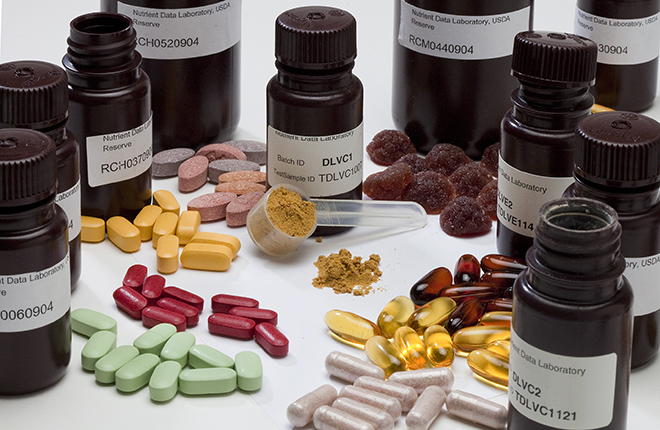Database for Nutrient Content of Supplements
The latest update of a database that validates the content of popular dietary supplements has been launched to help researchers more accurately determine relationships between dietary supplement use and public health. About half of U.S. adults consume dietary supplements. But it’s only been in the last decade that data has been collected on daily dietary supplement intakes during consumption surveys.
Research nutritionists translate “foods eaten” into “nutrients consumed” based on data collected during dietary-intake surveys and studies. The third and latest edition of the newly launched data resource—the Dietary Supplement Ingredient Database Version 3.0 (DSID-3)—is designed to help researchers estimate “total nutrient intakes.” Estimates of total nutrient intakes are based on the foods, beverages, and dietary supplements people consume.
Agricultural Research Service and National Institutes of Health (NIH) scientists released the DSID-3 this year. Geared for professional-research use, the DSID-3 website has averaged more than 13,500 unique visitors each month. The database reports nationally representative estimates for the ingredient content in four categories of dietary supplement products consumed in the United States.
Analytical methods used for testing ingredients evolve over time and vary by laboratory. The ARS researchers rely on National Institute of Standards and Technology resources to evaluate the quality of data received from multiple testing laboratories.
“Other dietary supplement databases contain label information only,” says ARS project manager Karen Andrews. “The DSID-3 can be used to gauge the accuracy of label-reported ingredient levels in population studies.”
Most multivitamin and mineral supplements (MVMs), for example, contain iodine. But the DSID-3 has shown that labels for adult, child, and over-the-counter prenatal MVMs consistently underreport iodine levels by about 25 percent based on chemical analyses.
“If iodine intake from MVM use alone is being tracked for a research study and the amount of iodine consumed is based on label information, then iodine intake would be underestimated by about 25 percent, on average,” says Andrews.
Andrews and other researchers at the ARS Nutrient Data Laboratory, part of the Beltsville Human Nutrition Research Center, and the NIH Office of Dietary Supplements developed the DSID with other government collaborators.
Updated ingredients in both adult and child MVMs are included. Also, for the first time, analysis-based estimates on prenatal over-the-counter MVMs and omega-3 fatty acids in fish and plant oil supplements are included.
Omega-3 fatty acid dietary supplements were defined as fish oil, plant oil, and fish/plant oil blends sold for the primary purpose of increasing the consumer’s omega-3 fatty acid intake. Labels on some of the omega-3 supplements tested reported only a total omega-3 content, but about 85 percent of the products listed an amount for at least one of the major omega-3 fatty acids—ALA, EPA, and DHA.
To access DSID-3, click this link.
Future releases of the DSID are planned to include evaluation of other supplements, including botanicals, and prenatal MVMs that are available only by prescription.—By Rosalie Marion Bliss, Agricultural Research Service Information Staff.
“Database for Nutrient Content of Supplements” was published in the December 2015 issue of AgResearch Magazine.
Key Facts
- A database validates the accuracy of label-reported ingredient levels in dietary supplements.
- Newest release includes prenatal vitamins and omega-3 supplements.
- Future releases to include botanical supplements.
Full Story







